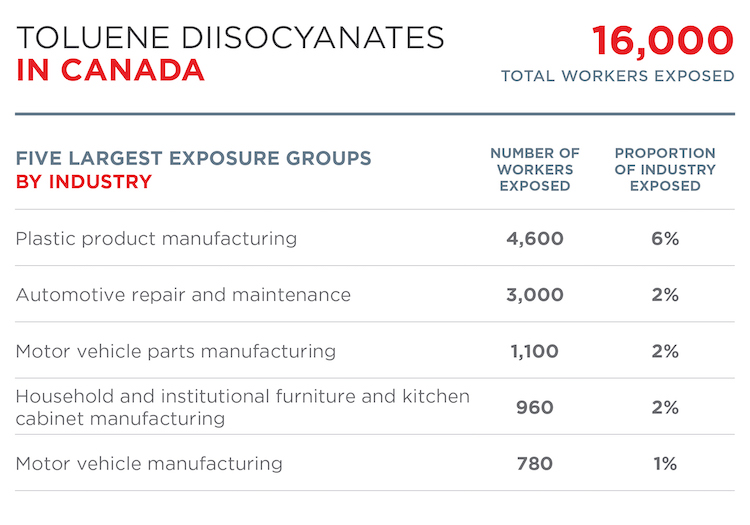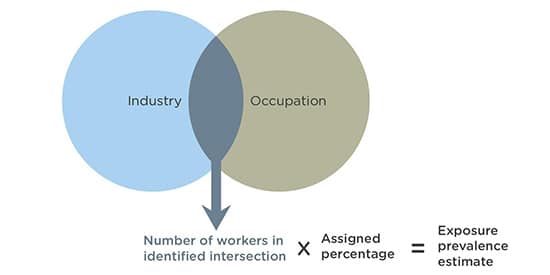Toluene Diisocyanates Occupational Exposures

CONTENTS
Toluene Diisocyanates Occupational Exposures
Overview
Workers may be exposed during all phases of toluene diisocyanates (TDI) manufacture and use. Inhalation and dermal contact are the most important routes of occupational exposure.[1] CAREX Canada estimates that approximately 16,000 Canadians are exposed to TDI in their workplaces.
READ MORE...
The largest industrial groups exposed are automotive repair and maintenance, plastic product manufacturing, and motor vehicle parts manufacturing.
The largest occupational groups exposed include automotive service technicians, truck and bus mechanics, and mechanical repairers; plastics processing machine operators; motor vehicle body repairers; and plastic products assemblers (finishers and inspectors). Other occupations potentially exposed include adhesive workers, insulators, lacquer applicators, organic chemical synthesizers, paint and urethane foam sprayers, ship builders, textile processors, and wire coating workers.[1] Potential for exposure also exists with processes involving heating (welding, soldering, or hot-wire cutting) polyurethane products.
Prevalence Estimate
Results show that approximately 16,000 Canadians are exposed to TDI in their workplaces; 78% of these workers are male. Industries with the greatest number of exposed workers are automotive repair and maintenance, plastic product manufacturing, and motor vehicle parts manufacturing.
The largest occupational groups exposed include automotive service technicians, truck and bus mechanics, and mechanical repairers; plastics processing machine operators; motor vehicle body repairers; and plastic products assemblers (finishers and inspectors).
When exposure is examined by occupation, the largest exposed groups are automotive service technicians, truck and bus mechanics, and mechanical repairers (2,100 workers exposed); plastics processing machine operators (1,900 workers exposed0; motor vehicle body repairers (1,300 workers exposed); and plastic products assemblers (finishers and inspectors) (1,300 workers exposed).
The number of workers exposed to toluene diisocyanates decreased by approximately 7,500 workers from 2006 to 2016 (a 31% decrease). This was primarily driven by a decrease in the number of workers in the plastics and rubber manufacturing industries.
Workers exposed to toluene diisocyanates by industry in 2016

Workers exposed to toluene diisocyanates by region in 2016
Click the second tab to view total number of workers exposed.
* = < 50 workers
Methods and Data
Our Occupational Approach page outlines the general approach used to calculate prevalence and exposure level estimates for workplace exposures.
Data Sources
Data used in developing the occupational estimates for toluene diisocyanates (TDI) were collected from several sources:
- The Canadian Workplace Exposure Database (CWED) contains approximately 3,000 measurements for TDI exposure. These measurements were collected during the years 1981 to 2004 in Ontario and British Columbia workplaces.
- Canadian and US scientific peer reviewed publications that addressed TDI exposure in Canada and the United States.
- Grey literature including technical reports from governments and international bodies.
Prevalence Estimate Method
CAREX defines exposure to TDI as inhalation or dermal exposure above levels that are generally encountered in the environment.
To determine the number of workers potentially exposed to TDI at work, CAREX occupational exposure experts used methods previously established in other peer-reviewed CAREX projects in Europe. A series of steps were taken to assign exposure proportions to occupations and industries at risk of exposure to TDI.

- Occupations and industries at risk of possible exposure to TDI were identified using any combination of data sources described above.
- The total number of workers in each identified occupation and industry intersection was obtained from Statistics Canada 2016 census data.
- A percentage of workers exposed was assigned to that occupation and industry intersection. Percentages were determined by consultation with existing evidence in the data sources, previously established methods from the Europe CAREX estimates and the expert judgement of CAREX occupational hygienists.
- The number of workers in the identified group is multiplied by the assigned percentage to calculate the prevalence estimate of workers exposed to TDI.
Sources
Subscribe to our newsletters
The CAREX Canada team offers two regular newsletters: the biannual e-Bulletin summarizing information on upcoming webinars, new publications, and updates to estimates and tools; and the monthly Carcinogens in the News, a digest of media articles, government reports, and academic literature related to the carcinogens we’ve classified as important for surveillance in Canada. Sign up for one or both of these newsletters below.
CAREX Canada
School of Population and Public Health
University of British Columbia
Vancouver Campus
370A - 2206 East Mall
Vancouver, BC V6T 1Z3
CANADA
As a national organization, our work extends across borders into many Indigenous lands throughout Canada. We gratefully acknowledge that our host institution, the University of British Columbia Point Grey campus, is located on the traditional, ancestral and unceded territories of the xʷməθkʷəy̓əm (Musqueam) people.


